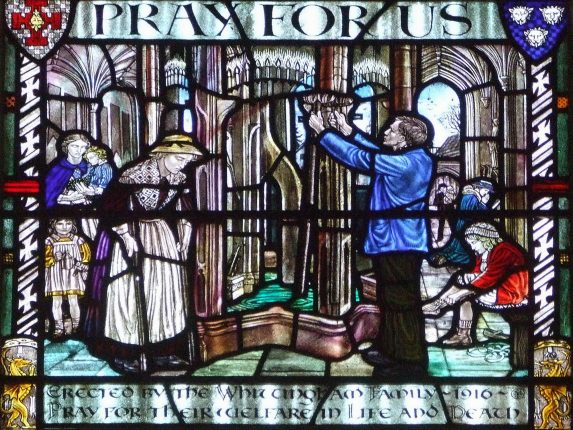Catholic Church of Saint Peter & Saint Paul, Newport, Shropshire
Address
Catholic Church of Saint Peter & Saint Paul, Salters Lane, Newport, Shropshire TF10 7LBTheme
Overview
The cousins Margaret Agnes Rope (1882-1953) of Shrewsbury (professional name: Margaret Rope, later Sister Margaret of the Mother of God) and Margaret Edith Aldrich Rope (1891-1988) of Leiston (professional name M E A Rope or M E Aldrich Rope) were prominent international stained-glass artists in the Arts & Crafts idiom. Their work can be seen in many churches and other buildings in England, Scotland and Wales as well as in Australia, Italy, South Africa, Sri Lanka, Trinidad and the USA.
Although their lives and styles diverged, they worked together at the start of their careers and again right at the end of the elder Margaret’s life.
Highlight
5 large windows: Saints Peter, Paul, Winefride, Nicholas and Help of ChristiansArtist, maker and date
Margaret Agnes Rope, 1912-16Reason for highlighting
Intensely designed, painted, detailed. Rich in colour and hidden secrets. These windows are the glory of Margaret Rope’s first period.
Artist/maker notes
Margaret Agnes Rope (1882-1953) was born in Shrewsbury and studied at the Birmingham School of Art, where – within a range of disciplines – she studied stained glass under Henry Payne. After the death of her father she joined the Roman Catholic church, and her faith became an overwhelmingly important focus of her life and work.
She began working from home, before moving to work at Lowndes & Drury in London. Initially, she directly supervised the work, but in 1923 she became a Carmelite nun. She continued making windows at the Monastery, sending the glass by train to Lowndes & Drury to be cut, fired and leaded up.
Further reading:
The Margaret Rope Stained Glass website
Margaret Rope of Shrewsbury by Arthur Rope (Pangapilot Publications, 2016)
The Two Margaret Ropes: Arts and Crafts Stained Glass Artists by Arthur Rope (Blurb, 2017)
Lowndes & Drury was founded in 1897, by the artist Mary Lowndes (1857-1929) and the craftsman Alfred John Drury (1868-1940), with the aim of providing facilities for independent artists to design and make stained glass windows. They moved from cramped conditions in Chelsea to newly purpose-built premises, The Glass House, in 1906. The firm continued after the founders’ deaths, under Alfred Drury’s son, Victor, until he retired in the early 1970s. However, The Glass House premises continued in use under Carl Edwards and subsequently his daughter, Caroline Benyon, until she moved her studio to Hampton in1992.
Source The Journal of Stained Glass, Vol. XLI, 2017



Other comments
For a preview of the windows see the Church website.
Contact in advance to visit: 01952 811299.